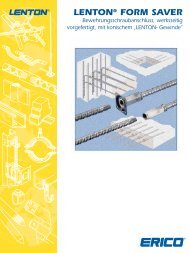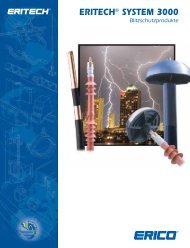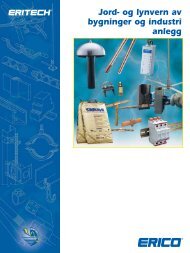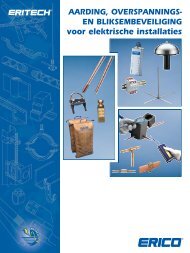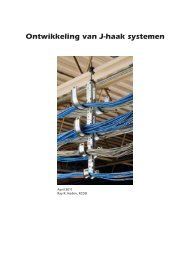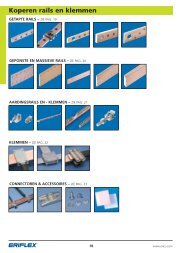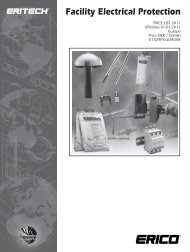Coordinated Facility Protection Catalog - Erico
Coordinated Facility Protection Catalog - Erico
Coordinated Facility Protection Catalog - Erico
You also want an ePaper? Increase the reach of your titles
YUMPU automatically turns print PDFs into web optimized ePapers that Google loves.
Glossary of Terminology<br />
8/20μs Current Waveshape<br />
A current impulse with a virtual front time of 8μs and a time<br />
to half-value of 20μs.<br />
Aggregate Surge Rating<br />
The sum of the surge ratings of individual voltage limiting<br />
components, connected in parallel, in the device.<br />
Note: This fi gure does not indicate the maximum discharge current (Imax) of<br />
the device. It does however provide an indication of the expected SPD life.<br />
Users should be aware that certain manufacturers may incorrectly claim the<br />
aggregate surge rating of MOV material used in their device as its Imax.<br />
Non-perfect current sharing between parallel MOVs, and the inability of<br />
series over-current or thermal disconnects to carry the full surge current,<br />
generally means that the maximum discharge current which the SPD can<br />
withstand is less than its aggregate surge rating.<br />
Attenuation<br />
The ability of an SPD to reduce electrical noise interference,<br />
measured in decibels. Attenuation varies with frequency,<br />
so it is usual to specify the attenuation of the SPD at a<br />
particular frequency; commonly 100kHz.<br />
Backup Overcurrent <strong>Protection</strong><br />
An external overcurrent protective device installed prior to<br />
the SPD. Such a device may be required if the overcurrent<br />
limiting device on the service is larger than that required by<br />
the SPD or connecting wiring.<br />
Class I test<br />
SPD tested with maximum impulse current (Iimp) and nominal<br />
discharge current (In).<br />
Class II test<br />
SPD tested with maximum discharge current (Imax) and<br />
nominal discharge current (In).<br />
Class III test<br />
SPD tested with combination wave.<br />
Distribution System<br />
Defi nes the electrical power distribution system. The<br />
distribution system is usually described by confi guration of<br />
the phases, neutral and ground conductor confi guration on<br />
the secondary side of the supply transformer. Refer to pages<br />
10-12 for further information.<br />
Follow Current (If)<br />
The current supplied by the electrical power distribution<br />
system which fl ows through the SPD after a discharge<br />
current impulse. The follow current is signifi cantly higher<br />
than the operating current, and is normally high for voltage<br />
switching type SPDs (e.g. spark gaps) since the arc voltage<br />
falls below the AC supply voltage after fi ring.<br />
Impulse Current (Iimp)<br />
Peak impulse current withstand with a 10/350μs current<br />
waveshape. This is often used for the classifi cation of<br />
SPDs tested to Test Class I, but is not the only acceptable<br />
waveshape.<br />
Insertion Loss<br />
The insertion loss of an SPD is usually only stated for two<br />
port devices for use on low voltage data systems. It is a<br />
measure of the ratio of voltage at the output to the input at<br />
the device under test. The insertion loss is usually stated for<br />
a given frequency and measured in decibels.<br />
www.erico.com 17<br />
Leakage Current<br />
The current fl owing to the ground conductor when the SPD is<br />
connected to the nominal supply voltage Un.<br />
Let-through Voltage<br />
Another term often used to describe the measured limiting<br />
voltage.<br />
Note: This measurement may be carried out with, or without, the presence of<br />
the nominal AC power (Un) being applied to the SPD. As such, the results may be<br />
different and the user should take cognizance of this in making any comparative<br />
assessments.<br />
Location Categories<br />
Various standards attempt to defi ne the electrical environment at<br />
which an SPD may be installed, into location categories or zones.<br />
Note: The user should be aware that international consensus has not<br />
been reached on these classifi cations, nor on the size of expected<br />
surge activity, which may occur. Further, the user should note that the<br />
demarcation of these zones do not form literal boundaries, but are rather<br />
a gradual transition.<br />
Maximum Continuous Operating Voltage (Uc)<br />
The maximum r.m.s. or d.c. voltage which may be continuously<br />
applied to the SPD’s mode of protection without degradation or<br />
inhibiting its correct operation.<br />
Note: Specifi cations given in the catalog generally are phase (L-N) voltages.<br />
Maximum Discharge Current (Imax)<br />
The maximum single shot current, having an 8/20μs waveshape,<br />
which the SPD can safely divert.<br />
Measured Limiting Voltage<br />
The maximum voltage measured across the SPD’s terminals<br />
during the application of an impulse of specifi ed waveshape and<br />
amplitude.<br />
Modes of <strong>Protection</strong><br />
SPDs may provide protection line-to-ground, line-to-neutral,<br />
neutral-to-ground or in combinations thereof. These paths are<br />
referred to as the modes of protection.<br />
Note: The user is advised that not all modes require protection, and more is not<br />
necessarily better when selecting an SPD. As an example, the N-G mode is not<br />
required when the SPD is installed at the primary service entrance of a TN-C-S<br />
electrical distribution system, due to the Neutral-Ground bond at this point. The L-L<br />
mode is generally not provided for systems with neutral conductors since the L-N<br />
modes also protect the L-L modes. Similarly, the L-G mode can be protected via the<br />
L-N and N-G modes.<br />
Nominal Discharge Current (In)<br />
The peak value of the current fl owing through the SPD during<br />
the application an 8/20μs waveshape.<br />
Note: IEC 61643-1requires SPDs tested to Test Class II, to withstand 15 impulses<br />
at In followed by 0.1, 0.25, 0.5, 0.75 and 1.0 times Imax.<br />
Nominal (System) Voltage (Un)<br />
The L-N voltage by which an electrical power system is<br />
designated. Under normal system conditions, the voltage<br />
at the supply terminals may differ from the nominal voltage<br />
as determined by the tolerance of the supply system<br />
(normally +/- 10%).<br />
One-port SPD<br />
An SPD connected in shunt (parallel) with the circuit to be<br />
protected. A one port device may have separate input and<br />
output terminals, but without a specifi c series impedance<br />
between these terminals. This type of connection is also<br />
known as a Kelvin connection.






